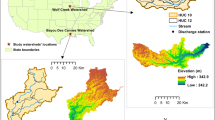Abstract
This paper investigated effects of Digital Elevation Model (DEM) resolution on flow simulation by applying the HSPF watershed model to three U.S. watersheds with different topographic conditions. Each watershed was delineated automatically and manually with four DEMs of the resolution ranging from 3.5 to 100 m. Results indicated that the simulated flow decreased with lowering DEM resolutions due to the reduction in the delineated drainage area particularly in low gradient watersheds. The DEM resolution impact was minimal when the manual method for watershed delineation was applied. The parameter uncertainty was found to be substantially greater than the resolution uncertainty in two out of three tested watersheds, indicating that the calibration of water balance parameters can alleviate the adverse effects of coarse DEM resolution for watersheds with high to moderate gradients. The findings are important to reducing the uncertainty, caused by DEM resolutions, in watershed modelling results, serving as guidelines for watershed modelling-based water resources management.



Similar content being viewed by others
Notes
The drainage area to the gage station (Bayou Des Cannes near Eunice) is 339 km2.
INFILT = infiltration, LZSN = lower zone storage nominal, AGWRC = groundwater recession rate, UZSN = upper zone storage nominal, DEEPER = fraction of groundwater inflow to deep recharge
References
Arabi M, Govindaraju RS, Hantush MM (2007) A probabilistic approach for analysis of uncertainty in the evaluation of watershed management practices. J Hydrol 333(2–4):459–471
Beven K, Binely M (1992) The future of distributed model: model calibration and uncertainty prediction. Hydrol Process 6:279–298
Bicknell BR (2000) Basins technical note 6: estimating hydrology and hydraulic parameters for HSPF. Environmental Protection Agency, US
Chaplot V (2005) Impact of DEM mesh size and soil map scale on SWAT runoff, sediment, and NO 3–N loads predictions. J Hydrol 312:207–222
Chaubey I, Cotter AS, Costello TA, Soerens TS (2005) Effect of DEM data resolution on SWAT output uncertainty. Hydrol Process 19(3):621–628
Cotter AS, Chaubey I, Costello TA, Soerens TS, Nelson MA (2003) Water quality model output uncertainty as affected by spatial resolution of input data. J Am Water Resour Assoc 39:977–986
Dixon B, Earls J (2009) Resample or not?! Effects of resolution of DEMs in watershed modeling. Hydrol Process 23(12):1714–1724
Fonseca A, Ames DP, Yang P, Botelho C, Boaventura R, Vilar V (2014) Watershed model parameter estimation and uncertainty in data-limited environments. Environ Model Softw 51:84–93
Freer J, Beven K, Ambroise B (1996) Bayesian estimation of uncertainty in runoff prediction and the value of data: an application of the GLUE approach. Water Resour Res 32:2161–2173
Gallagher M, Doherty J (2007) Parameter estimation and uncertainty analysis for a watershed model. Environ Model Softw 22:1000–1020
Gong Y, Shen Z, Hong Q, Liu R, Liao Q (2011) Parameter uncertainty analysis in watershed total phosphorus modeling using the GLUE methodology. Agric Ecosyst Environ 142:246–255
Hope A, Stein A, McMichael C (2004) Uncertainty in monthly river discharge predictions in a semi-arid Shrubland catchment. BHS 284–290
Jenson SK, Domingue JO (1988) Extracting topographic structure from digital elevation data for geographic information system analysis. Photogramm Eng Remote Sens 54:1593–1600
Kalin L, Govindaraju RS, Hantush MM (2003) Effect of geomorphologic resolution on modeling of runoff hydrograph and sedimentograph over small watersheds. J Hydrol 276:89–111
Kienzle S (2004) The effect of DEM raster resolution on first order, second order and compound terrain derivatives. Trans GIS 8:83–111
Moriasi D et al (2007) Model evaluation guidelines for systematic quantification of accuracy in watershed simulations. Trans ASABE 50:885–900
Moriasi D et al (2015) Hydrologic and water quality models: performance measures and evaluation criteria. Trans ASABE 58:1763–1785
Nash JE, Sutcliffe JV (1970) River flow forecasting through conceptual models part I — a discussion of principles. J Hydrol 10:282–290
Oksanen J, Sarjakoski T (2005) Error propagation analysis of DEM-based drainage basin delineation. Int J Remote Sens 26:3085–3102
Patil A, Deng Z, Malone RF (2011) Input data resolution-induced uncertainty in watershed modelling. Hydrol Process 25:2302–2312
Roostaee M, Deng Z (2018) Uncertainty analysis of watershed-based flow and water quality modelling with different DEM data sources. Ed HIC 2018. 13th international conference on hydroinformatics, 1778–1786
USEPA 2007. BASINS technical note 1: creating hydraulic function tables (FTABLES) for reservoirs in BASINS
USGS (2013) Federal standards and procedures for the National Watershed Boundary Dataset (WBD). Ed 2013
Wang H, Wu Z, Hu C (2015) A comprehensive study of the effect of input data on hydrology and non-point source pollution modeling. Water Resour Manag 29:1505–1521
Yang P, Ames DP, Fonseca A, Anderson D, Shrestha R, Glenn NF, Cao Y (2014) What is the effect of LiDAR-derived DEM resolution on large-scale watershed model results? Environ Model Softw 58:48–57
Zhang P, Liu R, Bao Y, Wang J, Yu W, Shen Z (2014) Uncertainty of SWAT model at different DEM resolutions in a large mountainous watershed. Water Res 53:132–144
Funding
This research was supported by the United States Geological Survey through Louisiana Water Resources Research Institute.
Author information
Authors and Affiliations
Corresponding author
Ethics declarations
Conflict of Interest
There are no known conflicts of interest associated with this publication.
Availability of Data and Codes
Data and models will be available upon request.
Additional information
Publisher’s Note
Springer Nature remains neutral with regard to jurisdictional claims in published maps and institutional affiliations.
Electronic supplementary material
ESM 1
(DOCX 2.82 kb)
Rights and permissions
About this article
Cite this article
Roostaee, M., Deng, Z. Effects of Digital Elevation Model Resolution on Watershed-Based Hydrologic Simulation. Water Resour Manage 34, 2433–2447 (2020). https://doi.org/10.1007/s11269-020-02561-0
Received:
Accepted:
Published:
Issue Date:
DOI: https://doi.org/10.1007/s11269-020-02561-0




